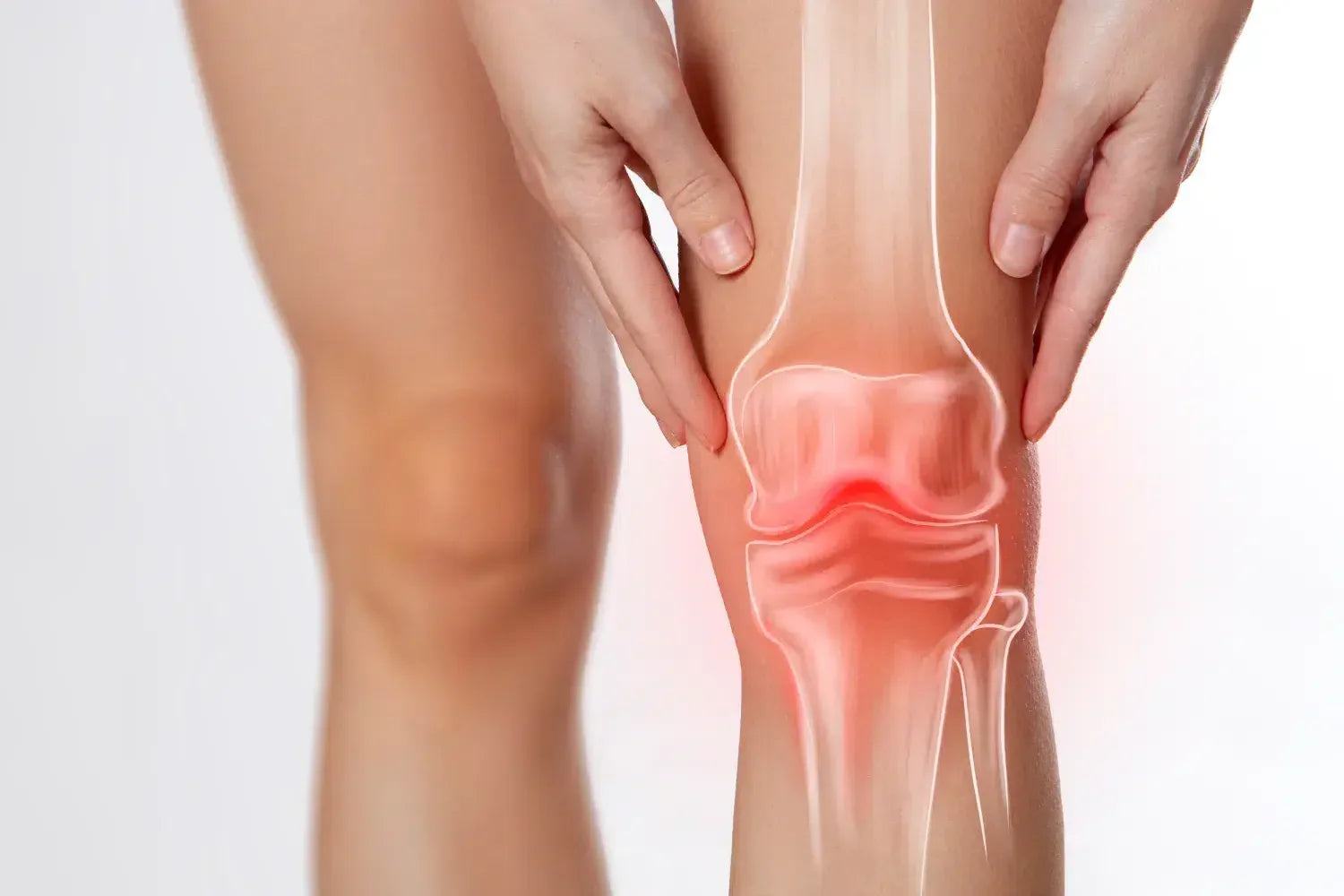Sciatica Knee Pain: Causes and Relief Options
|
| Sciatica is a term that's often thrown around when discussing lower back and leg discomfort. But what is it really, and how does it relate to that nagging feeling in your knee? |
If you've found yourself asking these questions, you've landed in the right place. This article aims to give you a clear understanding of what sciatica is, how it can affect your knee, and the different relief options that could help you find comfort.
Sciatica is not a condition in itself but a symptom. It occurs when there's pressure or damage to the sciatic nerve, the longest nerve in your body that starts from your lower back, extends through your hips and buttocks, and travels down each leg.
This pressure or damage can result in discomfort anywhere along the path of the nerve — including your knee. So, let's discuss sciatica and explore how you can manage discomfort.
What Is Sciatica?
The sciatic nerve plays a major role in our body. It's responsible for connecting our spinal cord with our leg and foot muscles, and it also delivers sensations to these areas. When this nerve faces any kind of pressure or damage, it can lead to a range of sensations, from mild discomfort to a severe throbbing feeling that can make even simple movements challenging.
Sciatica discomfort commonly occurs due to conditions that impact the lower spine, such as a herniated disc, spinal stenosis, or a bone spur. These conditions can compress the sciatic nerve, leading to what we know as sciatica.
How does sciatica relate to your knee? The answer lies in the concept of referred discomfort. Referred discomfort is when you feel sensations in a part of your body that are distant from the actual source of the problem. In this case, the discomfort is felt in the knee due to issues originating from the lower back or hip, where the sciatic nerve might be compressed.
The knee doesn't have a direct connection to the sciatic nerve, but it's still a common site for sciatica-related discomfort. This is because the sciatic nerve, as it travels down the leg, sends branches to the knee and lower leg muscles. When there's an issue with the main nerve, these branches can carry the signal of discomfort to the knee.
What Are Common Causes of Sciatica Knee Discomfort?
When we talk about sciatica causing knee discomfort, we're really talking about the conditions that can put pressure on the sciatic nerve. This pressure can lead to a variety of sensations that manifest in different parts of the body where the nerve extends, including the knee.
Here are some of the most common causes:
Lumbar Herniated Disc
A lumbar herniated disc, often known as a slipped disc, is one of the most common triggers of sciatica. This occurs when the soft inner material of a disc in the spine leaks out, or herniates, through the tougher outer layer. This herniated material can then compress the nearby sciatic nerve, causing discomfort that can radiate down the leg and into the knee.
Degenerative Disc Disease
As we age, the discs in our spine can naturally wear down, leading to degenerative disc disease. This wear and tear can cause the disc to lose its flexibility and shock-absorbing properties.
As a result, the space between the vertebrae may narrow, and the disc itself may protrude and impact the sciatic nerve. This can lead to discomfort in the lower back that extends to the knee.
Lumbar Spinal Stenosis
Lumbar spinal stenosis is a condition in which the spinal canal in the lower back narrows. This narrowing can put pressure on the nerves traveling through the lower back, including the sciatic nerve. When this happens, you may experience discomfort that extends from the lower back through the leg and into the knee.
What Are the Symptoms of Sciatica Knee Discomfort?
Knowing the symptoms of sciatica knee discomfort is essential for recognizing the condition and seeking appropriate relief options. It's important to remember that sciatica symptoms can vary in intensity and type from person to person and even from day to day.
The primary symptom of sciatica is a radiating discomfort that originates in the lower back or buttock and travels down the path of the sciatic nerve. When this discomfort reaches the knee, it can manifest in several ways. People often describe this as a burning, tingling, or searing sensation. It's not typically a localized feeling but spreads along the path of the sciatic nerve.
You might experience numbness in the area of the knee or a weakness in the leg that makes it difficult to perform certain movements. This could be as subtle as a slight drag of the foot or as noticeable as a struggle to rise from a sitting position. A tingling sensation or a feeling similar to pins and needles in your knee or leg could also be a symptom of sciatica.
Keep in mind that everyone's experience with sciatica is unique. If you're noticing discomfort in your knee along with some of these other symptoms, it could be related to your sciatic nerve. As always, it's important to consult with a healthcare professional for a proper diagnosis and personalized relief options.
What Are Relief Options for Sciatica Knee Discomfort?
Living with the discomfort of sciatica in your knee can feel like a challenge, but there are several strategies that could potentially support relief. From making simple lifestyle changes to trying out different therapies, let's explore some options that may help you on your journey to comfort.
Lifestyle Changes
Believe it or not, the way you live your day-to-day life can have a significant impact on your well-being. Maintaining a healthy weight, for instance, can help lessen the pressure on your spine, reducing the likelihood of sciatic nerve compression.
Staying active and incorporating low-impact activities like swimming or walking can also promote a healthier spine and potentially ease sciatica-related knee discomfort.
Stretch Regularly
Regular stretching can be a game-changer when it comes to managing sciatica discomfort. Stretches that specifically target the lower back, hips, and legs can help maintain mobility and flexibility and support better posture. It's always a good idea to consult with a physical therapist or healthcare provider to ensure you're doing these stretches correctly and safely.
Try Acupuncture
Acupuncture, a practice that involves inserting thin needles into specific points on the body, has been recognized by some as a potential relief option for sciatica discomfort. While it's not entirely understood how acupuncture works in relieving discomfort, it's thought that it might promote the release of endorphins, the body's natural pain-relieving chemicals.
Consider a Massage
A good massage can do wonders for your well-being. For those experiencing sciatica knee discomfort, massage therapy might help by relaxing tight lower back muscles that are putting pressure on the sciatic nerve. It's a soothing way to potentially ease discomfort and promote relaxation.
Add CBD to Your Routine To Support Overall Wellness
Cannabidiol (CBD), a non-intoxicating compound found in cannabis, is gaining recognition for its potential to support overall well-being. When applied topically, CBD can interact with the endocannabinoid system (ECS) — a complex cell-signaling system in our bodies that plays a role in maintaining a variety of functions and processes.
By supporting the ECS, topical options like our CBD balm could help maintain balance and ease in the body.
Finding relief from sciatica knee discomfort often involves a bit of trial and error to see what works best for you. Consult with a healthcare provider before starting any new treatment or therapy. With the right approach and a bit of patience, you can start heading toward a more comfortable life.
When To See a Doctor About Knee Discomfort
While it's normal to experience occasional discomfort in the knee, particularly after a long day or intense workout, persistent or severe discomfort could be a sign of an underlying issue, such as sciatica.
If you're noticing discomfort that radiates from your lower back or hip down to your knee, or if you're experiencing symptoms like numbness, tingling, or weakness in your leg or knee, it's time to consult a healthcare professional.
Diagnosing sciatica involves a physical examination where your doctor may ask you to perform certain movements to check your muscle strength and reflexes. In some cases, imaging tests like X-rays or MRIs might be required to determine the underlying cause of your discomfort.
The good news is there are several medical treatments available for sciatica-induced knee discomfort. Physical therapy, for instance, can help you improve your posture, strengthen the muscles supporting your back, and enhance your flexibility.
Medications, like over-the-counter pain relievers, might also be recommended to manage discomfort. In severe cases, surgery might be considered to relieve the pressure on the sciatic nerve.
The Bottom Line
Living with sciatica knee discomfort can be a long journey toward relief. Understanding the causes, recognizing the symptoms, and exploring various relief options are key to finding comfort. Don't hesitate to seek professional advice if you're experiencing persistent or severe discomfort in your knee.
At Muscle MX, we're committed to supporting your wellness journey. We understand the importance of natural, clean ingredients, and that's why our balms, oils, and gummies are crafted with the utmost care. Each product undergoes rigorous third-party testing to ensure quality and safety.
We invite you to explore our full range of soothing CBD products to support your overall wellness.
Sources:
Sciatica | Mayo Clinic
Stretches and Exercises for Knee Pain, from a PT | HSS
Acupuncture | John Hopkins
The endocannabinoid system: Essential and mysterious | Harvard Health

















































